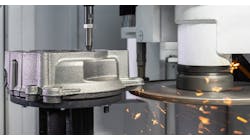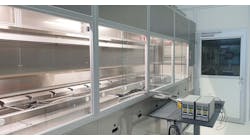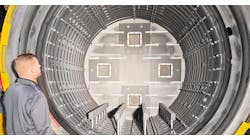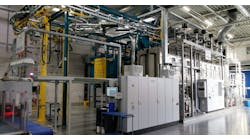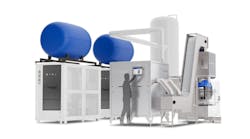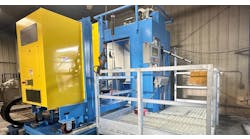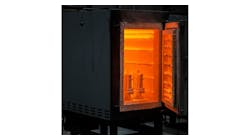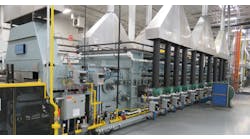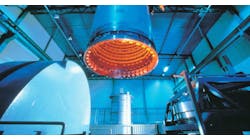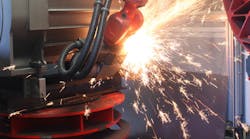Metalcasters are gaining a deeper appreciation for robotic automation in their operations, particularly high-throughput foundries that can take advantage of the consistency and availability that robots bring to grinding and finishing. Automation makes it affordable to process high volumes of castings with the process quality and proficiency that individual grinders cannot maintain.
In the course of this development, foundries have gained greater attention from robotics developers, who are designing and customizing more models for the heavy-duty work of metalcasting. And this is creating a new role for robotics systems integrators. Evolut SpA is an Italian robotics system developer that launched more than 20 years ago, and now lists more than 2,000 installations where it has integrated robotized automation for foundries, automotive manufacturing, and general industrial operations.
Working with robot builder and automation developer Comau, Evolut implemented two systems for grinding and deburring aluminum and iron castings, operations that now perform with maximum repeatability and cycle-time reduction for the respective metalcasters.
In addition, the processes are now much less demanding for the grinding process operators. Ensuring maximum operational efficiency and making the work of operators more sustainable are two critical objectives in automating foundries’ grinding and deburring departments. In fact, these processes require exceptional precision according to the types of materials to be processed and the complexity of a particular foundry’s operation. Both factors underscore the importance of a systems integrator.
The integrator’s task is to customize systems that will resolve specific production problems, using the most suitable automation concepts. According to Evolut, this is possible by establishing a strategic partnership with the robotics developer — which it has done with Comau. In the recent past, the partners worked together to automate two grinding and deburring systems, one for aluminum castings and another for iron castings.
“The companies we worked for needed to implement grinding and deburring systems that are able to eliminate errors thanks to the high repeatability of the system, ensuring reduced cycle times and more sustainable working conditions for the operators,” explained Franco Codini, the owner of Evolut SpA.
“These operations have different levels of complexity, not only in terms of the specific pieces to be processed, but also the material that must be cut or deburred. This is why the use of the most suitable technology is always essential for us,” he added.
Codini also said the two projects are examples of the partners’ capabilities for achieving production efficiency and operational safety.
The first project was implemented at a Russian automotive foundry, grinding and deburring cast aluminum parts. The second was developed for grinding and deburring iron castings for a German foundry supplying parts for the energy sector. In both applications, process optimization was possible thanks to a laser-based dimensional system for detecting the workpieces – with automatic correction of deformities on the unprocessed parts – and an offline pre-process programming for hollow-wrist Comau robots with the “Absolute Accuracy” configuration.
Grinding and Deburring Aluminum
The first application developed by Evolut with Comau is a dedicated process for grinding and deburring cast aluminum engine blocks and cylinder heads. “The system is necessary to cut the sprues and burrs that are produced during the casting process,” Franco Codini explained. “We use a Comau robot, the Smart NJ 220-2.7 Foundry unit with a load capacity of 220 kg, that is equipped with a 22-kW electrospindle and HSK 63 automatic tool coupling. Also, the rear parallelogram structure increases the robot’s rigidity and makes the system extremely satisfactory when it comes to the required grinding and deburring operations.”
The installation is able to use cut-off wheels and milling machines of different sizes, and on a rigid rotary table equipped with a hydraulic apparatus that holds the workpieces in a predetermined position. Each casting weighs up to 25 kg, with overall dimensions of about half a cubic meter.
“Among the tasks executed in this foundry department are grinding and deburring of castings made with low precision. However, in this case, the client’s request was to produce a process that could be repeated as often as possible within ± 0.15 mm. This was the real difficulty of the application,” the automation developer said. “To meet this need, we equipped the Comau robot with a laser vision system that enabled the measurement of the pieces and subsequently, the proportional compensation of the errors found on the piece. The grinding process was performed using offline programs – developed by Evolut in collaboration with a major software developer– based on a 3D drawing of the piece, through which the technician is able to follow the tool from a computer using a CAM program.”
Basically, this operation allows automatic correction of the direction of the robot based on the data collected, creating a model process that is performed on an ideal piece, which will be automatically corrected according to the real piece to be produced.
“The advantages of this application are remarkable,” Codini continued. “Using the vision system, combined with Comau robots, we have achieved excellent levels of repeatability, and are able to guarantee the precision required by the foundry with a maximum tolerance of ± 0.1 mm. In addition, this method has allowed us to simplify considerably the work of the operator, who can follow the whole process from a computer monitor while all the heavy and difficult tasks are automated.”
Grinding and Deburring Cast Iron
The second system implemented by Evolut is based on a Comau Smart NH3-220-2.7 Foundry robot. In this case, it is used by a foundry casting iron parts for energy-sector machinery, grinding and deburring castings with varying dimensions – and weights ranging from 15 to 60 kg. The range of dimensions and the material give this installation a higher margin for error due.
“Again, for this application an optimal process was developed offline and then reconfigured on the basis of the actual process,” said Codini. “The key difference between the two systems, however, is the different role for the robot in the applications.”
In the work cell developed for processing automotive parts, a function called “tool on board” involves a milling device on the robot wrist, which is the working tool. By contrast, in the second installation, a function called “piece on board” has been programmed, which is typical for foundries processing cast iron parts. In the latter case, the robot manipulates the workpiece and not the electrospindle. On the wrist of the robot there is a gripper to pick up the workpiece, which then is cut and deburred using a grinder that operates directly on the component.
“The process developed for the (second) system is useful for large-batch production,” Franco Codini emphasized. “Moreover, in this case, we drastically reduced the manual tasks carried out by the operators, thereby increasing the quality and sustainability of their work.”
With this method, all the operator has to do is load the workstation. The rest of the time can be devoted to the quality control of a process that, being automated, is in itself, already reliable due to the repeatability guaranteed by the robot.
This represents a significant advantage to the foundry, considering that grinding and deburring iron castings is an extremely demanding and stressful assignment for the operators, not only because of the environment, but also because of the high strain of vibratory energy discharged on an operator’s muscles and frames
There are other advantages to using an automated cell. “The automated system for grinding and deburring of cast iron parts makes it possible to reduce the cycle time for grinding a part by three times, compared to what we would get if some of the operations were managed by an operator, and this is made possible by the Comau robot.”
To make its applications even more efficient, Evolut selected Comau’s “Absolute Accuracy” robot configuration with a hollow wrist. Hollow-wrist robots have power and control cabling integrated through the arm, which makes them simple to install into a new or existing cell, with better robot performance and less maintenance because there is less wear on the cables. It also give the operators more tooling options for the robot, allows greater access, has a wider working envelope, and makes it possible to coordinate the robot with other machines or robots, all because the power and control cabling does not obstruct the system.
“The possibility of using a robot with a hollow wrist optimizes even more the performance offered by Comau,” according to Codini, “because the wires and cables are placed inside the robot wrist and are less exposed to wear and tear. This is a very important feature if these machines are used in harsh environments, such as foundries, where the presence of fragments and dust, and the exposure to high temperatures can damage the connections. Comau’s Absolute Accuracy configuration also ensures greater accuracy during the production process.”
With these expectations and thanks to the results obtained so far, both in terms of operational efficiency and safety for the operators, it appears clear that foundries are quickly proceeding toward an increasing degree of process automation.
“We believe that applications similar to those we implemented with Comau robots, which are already highly efficient, can be further improved in the future, and it is precisely in this direction that we are developing our plans for the years to come,” Codini said.
“At the moment, for example, we are conducting a study to develop a system for detecting errors on the workpieces by means of 3D vision systems. It will be much more evolved vision system than those that are commonly used in our plants, and one that will be able to detect the data of the pieces inside the work station. In addition, again in collaboration with Comau, we are trying to develop solutions to make the collaboration between man and robot even closer and safer, which is particularly important in harsh environments such as those in foundries.”
